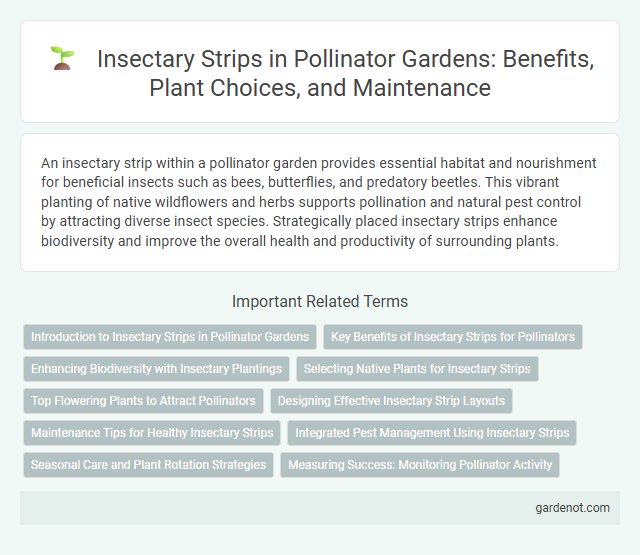An insectary strip within a pollinator garden provides essential habitat and nourishment for beneficial insects such as bees, butterflies, and predatory beetles. This vibrant planting of native wildflowers and herbs supports pollination and natural pest control by attracting diverse insect species. Strategically placed insectary strips enhance biodiversity and improve the overall health and productivity of surrounding plants.
Introduction to Insectary Strips in Pollinator Gardens
Insectary strips are specialized plantings designed to attract beneficial insects such as bees, butterflies, and predatory insects to pollinator gardens. These strips typically include a diverse mix of native flowering plants that provide nectar, pollen, and habitat throughout the growing season. Integrating insectary strips enhances pollination services, supports biodiversity, and improves the overall health of garden ecosystems.
Key Benefits of Insectary Strips for Pollinators
Insectary strips provide essential habitats rich in diverse flowering plants that supply pollen and nectar, crucial for the nourishment of pollinators such as bees, butterflies, and hoverflies. These strips enhance biodiversity by supporting beneficial insect populations and improving pollination rates, which directly contribute to increased crop yields and ecosystem health. By attracting natural predators and pollinators, insectary strips reduce the need for chemical pesticides, promoting sustainable agricultural practices.
Enhancing Biodiversity with Insectary Plantings
Insectary strips, composed of diverse flowering plants, significantly enhance biodiversity by providing essential habitats and food sources for pollinators such as bees, butterflies, and beneficial predatory insects. These targeted plantings increase local pollinator populations, improve pollination rates for adjacent crops, and support ecological balance through natural pest control. Strategic integration of insectary strips within pollinator gardens fosters resilient ecosystems and promotes sustainable agricultural practices.
Selecting Native Plants for Insectary Strips
Selecting native plants for insectary strips enhances pollinator attraction and supports local biodiversity by providing essential nectar and pollen resources. Native species such as milkweed, goldenrod, and coneflower thrive in local climates and offer habitat and food for beneficial insects like bees, butterflies, and predatory beetles. Incorporating a diverse mix of flowering plants with staggered bloom times ensures continuous forage throughout the growing season, maximizing pollinator presence and ecological benefits.
Top Flowering Plants to Attract Pollinators
Milkweed, goldenrod, and coneflower are top flowering plants in insectary strips renowned for attracting diverse pollinators such as bees, butterflies, and hoverflies. These plants provide abundant nectar and pollen, essential for the sustenance of pollinator populations and the enhancement of garden biodiversity. Integrating a variety of native wildflowers in insectary strips maximizes pollinator visitation and supports ecological balance.
Designing Effective Insectary Strip Layouts
Designing effective insectary strip layouts involves selecting diverse native flowering plants that bloom sequentially to provide continuous nectar and pollen sources for pollinators. Strategic placement of strips along crop edges or within fields maximizes habitat connectivity and enhances pollinator foraging efficiency. Incorporating structural diversity and avoiding pesticide drift zones further supports beneficial insect populations and improves overall garden biodiversity.
Maintenance Tips for Healthy Insectary Strips
Regularly inspect insectary strips for invasive weeds and remove them promptly to prevent competition with beneficial plants. Water the strips deeply but infrequently to encourage deep root growth and maintain soil moisture without waterlogging. Prune flowering plants after their peak bloom to stimulate new growth and extend flowering periods, enhancing habitat quality for pollinators.
Integrated Pest Management Using Insectary Strips
Insectary strips within pollinator gardens promote Integrated Pest Management (IPM) by attracting beneficial predatory and parasitic insects that naturally control pest populations. These strips support species such as lady beetles, lacewings, and parasitic wasps, reducing the need for chemical pesticides and enhancing biodiversity. Implementing insectary strips improves crop health and yield by fostering a balanced ecosystem where pest outbreaks are minimized through biological control agents.
Seasonal Care and Plant Rotation Strategies
Insectary strips require seasonal care such as regular pruning, mulching, and targeted watering to maintain plant health and maximize pollinator attraction. Implementing plant rotation strategies by alternating flowering species each season prevents soil nutrient depletion and suppresses pests, enhancing overall garden biodiversity. Selecting native, nectar-rich plants tailored to local pollinator activity periods optimizes habitat sustainability and insectary effectiveness.
Measuring Success: Monitoring Pollinator Activity
Measuring pollinator activity in insectary strips involves systematic observation and data collection on species diversity, visitation frequency, and behavior patterns. Tools such as transect walks, timed counts, and photographic documentation provide quantitative insights into pollinator presence and ecosystem health. Analyzing this data helps optimize planting strategies to enhance pollination efficiency and biodiversity in pollinator gardens.
Insectary strip Infographic

 gardenot.com
gardenot.com